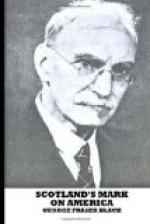etc. William Hart (1823-94), born in Paisley,
became an Academican in 1857, and was afterwards President
of the Brooklyn Academy and of the American Water
Color Society. James McDougall Hart (1828-1901),
born in Kilmarnock, brother of William Hart, already
mentioned, Academican of the National Academy of Design,
was noted for his landscapes and paintings of cattle
and sheep. His “Summer Memory of Berkshire”
and his “Indian Summer” attracted considerable
attention at the Paris Salon in 1878. James David
Smillie (1833-1909), son of James Smillie, the Scottish
engraver, during the Civil War made designs for government
bonds and greenbacks. In 1864 he took up landscape
painting and was one of the founders of the American
Water Color Society (1867) and National Academican
in 1876. His brother, George Henry Smillie (b.
1840), was also distinguished as a landscape painter.
He made a sketching tour in the Rocky Mountains and
the Yosemite Valley in 1871, and became a National
Academican in 1882. Walter Shirlaw, born in Paisley,
Scotland, in 1838, died in Madrid, Spain, in 1909,
was the first President of the Society of American
Artists. His easel pictures “are marked
by rich color and fine composition, and he is one of
the few American artists who have successfully painted
the nude. His water-colors and etchings have
brought him high reputation in these forms of expression.”
Walter MacEwen, born in Chicago of Scottish parents,
has painted many pictures and has received medals and
decorations for his work. In 1895-96 he painted
nine large panels and a number of small ones for the
Hall of Heroes in the Library of Congress. George
Inness (1825-94), the famous American painter, is
believed to have been of Scottish ancestry. James
T. Dick (1834-68), William Keith (b. Aberdeenshire,
1839), Robert Frank Dallas (b. 1855), John White Alexander
(b. 1856), Robert Bruce Crane (b. 1857), Addison Thomas
Miller (b. 1860), and John Humpreys Johnston, are all
artists of Scottish parentage or Scottish ancestry.
John Robinson Tait (b. 1834), artist and author, son
of a native of Edinburgh, has written much on art
subjects. John Wesley Beatty (b. 1851), Art Director
of the Carnegie Institute, Pittsburgh, is of Scottish
parentage. John Ward Dunsmore (b. 1856), Director
of the Detroit Museum of Arts and Founder of the Detroit
School of Arts; and John Ferguson Weir (b. 1841),
Dean of the School of Fine Arts at Yale University,
are of Scottish descent.
Alexander Lawson (1773-1846), born in Lanarkshire, died in Philadelphia, was famous as the engraver of the best plates in Alexander Wilsons’s Ornithology and the plates on conchology for Haldeman and Binney. His son, Oscar A. Lawson (1813-54), was chart engraver of the United States Coast Survey, 1840-51. Samuel Allerdice engraved a large number of plates of Dobson’s edition of Rees’s Cyclopaedia, 1794-1803. Hugh Anderson, a Scot, did good line and stipple work in Philadelphia in the first quarter of the nineteenth




